

How to transform schools into Learning Organisa... Exploring the 5 Characteristics of the Global Digital Teacher #teacherquality #digitalcitizenship. 10 Practical Ways to Foster A Growth Mindset Culture in Your Class. Informe ODITE sobre Tendencias Educativas 2017. Becoming Innovative: 15 New Ideas Every Teacher Should Try - Becoming Innovative: 15 New Ideas Every Teacher Should Try by TeachThought Staff What are the latest emerging trends in education?
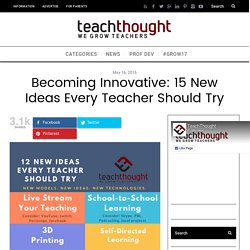
As trends to do, these are changing almost yearly. Consider how quiet iPads in the classroom have been recently, whereas three years ago they were going to replace teachers and were (unsarcastically) compared to magic. While mobile devices like the iPad can indeed parallel a kind of magic in the learning process, it obviously has to ‘fit’ into a progressive supporting ecology of assessment, curriculum, and instruction.
With that in mind, we’ve created a list of 15 (the graphic plus 3 bonus items below) new ideas every teacher should try. A suggestion? Metodologías educativas: ¿Por qué escoger solo una? En la actualidad, están surgiendo muchas metodologías educativas supuestamente revolucionarias.

A grandes rasgos, se puede decir que una metodología tiene que tener en cuenta las diferentes competencias que se quieran desarrollar, al mismo tiempo que debe implementar el aprendizaje de ciertos conocimientos de una materia en concreto, sin olvidar la atención a la diversidad, los diferentes estilos de aprendizaje y los intereses de los alumnos. Learning Progressions: Road Maps for 21st-Century Students—and Teachers. As our world grows more interconnected, conversations about education are shifting to focus on identifying and cultivating the complex “21st-century” skills children will need to succeed amid global competition and uncertainty.
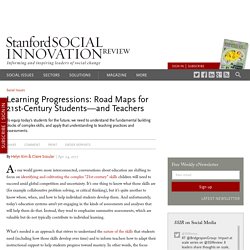
It’s one thing to know what those skills are (for example collaborative problem solving, or critical thinking), but it’s quite another to know where, when, and how to help individual students develop them. And unfortunately, today’s education systems aren’t yet engaging in the kinds of assessments and analyses that will help them do that. A nice reminder to share with your team or building when integrating technology. #goformative #edtech #purposeful. 5 things that are not Leadership! Love this infographic - so relatable to educational leadership. 28 Student-Centered Instructional Strategies - 28 Student-Centered Instructional Strategies by TeachThought Staff For in-person professional development from TeachThought on effective instructional strategies or any other topic your school or district might need, contact us today.
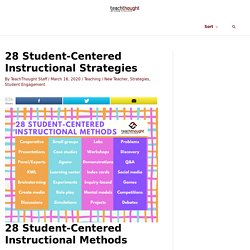
Student-centered teaching is teaching designed for the student. This means that planning often begins with the student in mind as opposed to a school policy or curriculum artifact, for example. Done well, it can disarm some of the more intimidating parts of academia, while also shortening the distance between the student and understanding. Put another way, student-centered teaching is teaching that is ‘aware’ of students and their needs above and beyond anything else. Las competencias clave para el aprendizaje permanente en el punto de mira de la agenda de las competencias. Picture: Images @ Shutterstock.com La Comisión Europea ha adoptado su nueva Agenda de competencias para Europa, en la que aparece el marco de competencias clave.
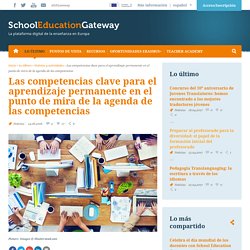
Teaching In 2017: A Checklist For 21st Century Teachers - Teaching In 2017: A Checklist For 21st Century Teachers by TeachThought Staff What are the kind of things a 21st century teacher needs to know and be able to do?
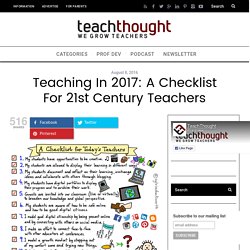
What about 21st century students? What are the 21st-century skills every student needs? The gap between the skills people learn and the skills people need is becoming more obvious, as traditional learning falls short of equipping students with the knowledge they need to thrive, according to the World Economic Forum report New Vision for Education: Fostering Social and Emotional Learning Through Technology.

Innedu. It's Past Time For Education 3.0 - Schools are doing Education 1.0; talking about doing Education 2.0; when they should be planning and implementing Education 3.0.

This post seeks to compare the developments of the Internet-Web to those of education. The Internet has become an integral thread of the tapestries of most societies throughout the globe. The web influences people’s way of thinking, doing and being; and people influence the development and content of the web. The Internet of today has become a huge picture window and portal into human perceptions, thinking, and behavior. Logically, then, it would seem that schools would follow suit in mimicking what is happening via the Internet to assist children and youth to function, learn, work, and play in a healthy, interactive, and pro-social manner in their societies-at-large.
Education 1.0. Focus 2 Achieve - Creativity Is A Superweapon: Help Your Students Seize And Use It. By Oskar Cymerman | @focus2achieve | BAM!

Radio Network & Teaching Channel Blogger A recent IBM survey of 1500+ CEOs revealed that CREATIVITY IS THE SINGLE MOST IMPORTANT LEADERSHIP SKILL necessary for success in the globalized market of today. Due to global competition, innovative solutions leaders come up with are often the difference between an enterprise staying relevant and meeting its demise. Creativity allows one to create. 12 Principles Of Modern Learning -
12 Principles Of Modern Learning by TeachThought Staff What are the principles of modern learning?
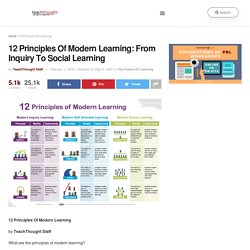
Well, that depends on how you define ‘learning’ and what you’d consider ‘modern.’ Digital competences in the classroom: an #eTwinning virtual lecture. Last March 18th I had the opportunity to offer a virtual lecture to the eTwinning community thanks to the invitation of Rute Baptista, Pedagogical and Professional Development Officer at EUN. The whole eTwinning project is one the most successful and fruitful educational strategies run in the European Union: it combines the power of Project Based Learning with the strengths of ICT, a well-oiled organization and thousands of teachers and students willing to create knowledge and values together across Europe.
The topic of my lecture was digital competence and how to make it real in the classroom. To start with, I needed to adopt a critical stance here: the point about this competence in particular is that probably it is the only competence which is business-driven. That is, the competence is inoculated in society via the consumption of electronic goods and devices, not at school or through educational practices. 5 skills students need to be contributing global citizens – Mr Kemp.
Following up from the honor of being selected in Huffington Posts Top 12 Global Education Blogs of 2014/2015 I have been chosen again in this amazing group and for 2016/2017 will be contributing to Huffington Post’s Education blog once a month. This month we look to answer the following highly controversial question “What are the important skills, behaviors, and attitudes that students need to become contributing global citizens?”
10 questions every teacher should ask themselves: #edchat #ntchat. Glosario de pedagogías emergentes. Blended Learning Visually Explained for Teachers. July 10, 2016 Here is a short visual we created for teachers explaining the core notions behind the concept of Blended Learning. We have also included a collection of what we believe are some essential web tools for classrooms that adopt a blended learning model of instruction. You can share, print and use the visual the way you want as long as you credit us as the source. 6 Ways to Become a 21st Century Teacher Infographic. Teacher Infographics 6 Ways to Become a 21st Century Teacher Infographic. Envisioning Future Education: 6 Exciting Predictions.
“Meet George Jetson!” My childhood Saturday mornings were spent imagining what the world would be like many years from then. Cities in the sky, automated rituals, robots working for us—it was the stuff of wonder. Countless humans have tried to predict what the future will be like. Some predictions have come true. Look at smartphones, web conferencing, and holograms, just to scratch the surface. We are, or have been, on the edge of a new horizon of the future. As the world changes and national walls disintegrate, so does the way we retain and use information. The 7 Commandments of Effective Studying [Infographic] 13 Educational Tools That Continue to Stand the Test of Time. El aula interactiva II: dale la “vuelta” a tu clase. El modelo The Flipped Classroom nos propone dar la vuelta a nuestra forma de trabajar.
Se trata de que el alumnado acceda a los contenidos en casa por medio de materiales audiovisuales propuestos por el profesorado, en los que se presenta el tema a trabajar y las ideas fundamentales, y aproveche las horas de clase para trabajar sobre las mismas. Edumorfosis: Informe Horizon 2016. Las seis tendencias claves que marcarán el futuro de la Educación Superior han sido precisadas por un grupo de 58 expertos que formaron parte del Informe Horizon 2016.
El mismo incluye hallazgos basados en encuestas realizadas sobre el futuro de la Tecnología Educativa. El resultado final consiste en la presentación de seis importantes desafíos y seis importantes desarrollos de la tecnología en el contexto educativo superior. Los participantes de este estudio tienen la esperanza de que la investigación realizada ayude a diseminar las decisiones que las instituciones educativas están tomando para mejorar, apoyar y ampliar la enseñanza, el aprendizaje y la investigación creativa en la educación superior a nivel global.